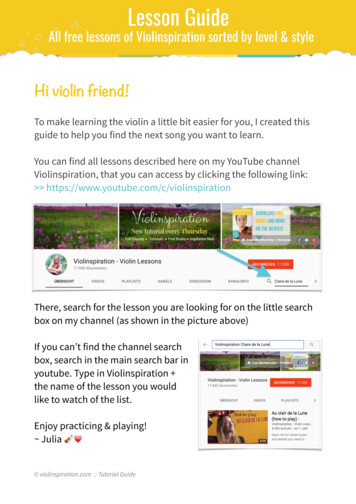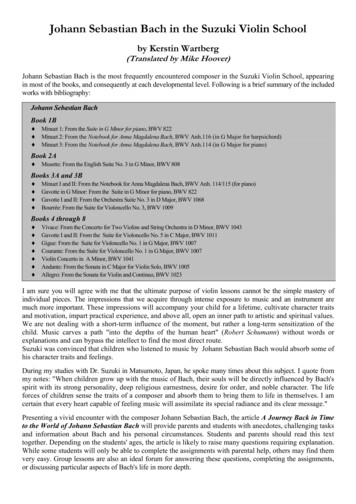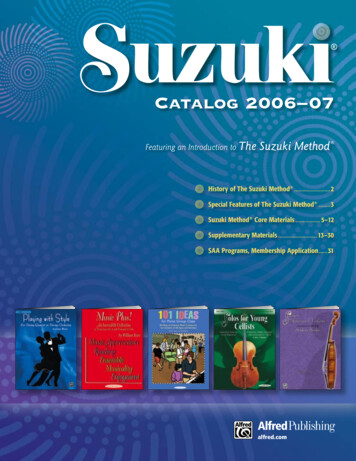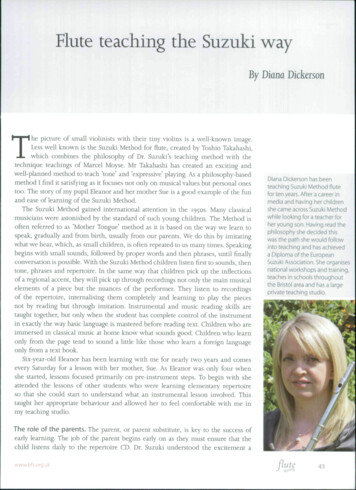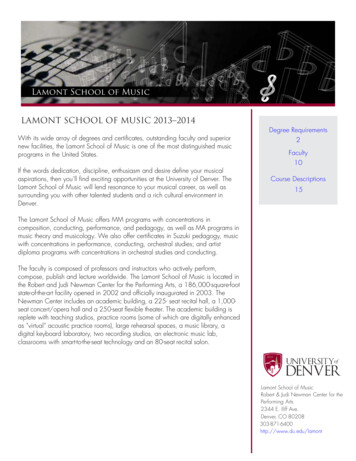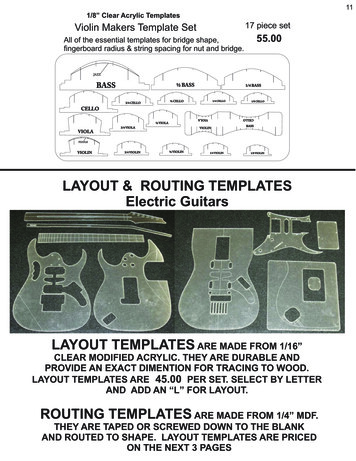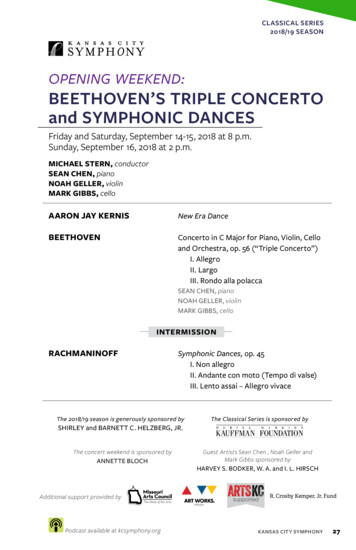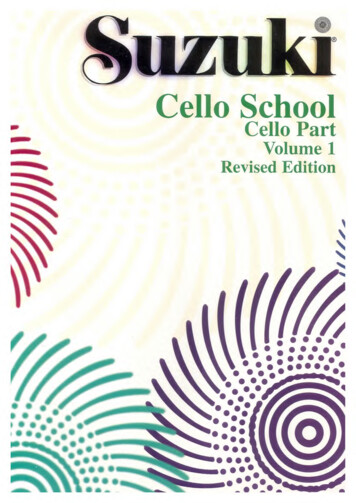
Transcription
Cello SchoolCello PartVolume 1Revised Edition
SuzukiCello SchoolCello PartVolume 1Revised Edition 1982, 1991 Dr. Shinichi SuzukiSole publisher for the entire world except Japan:Summy-Birchard Inc.exclusively distributed byWarner Bros. Publications15800 N.W. 48th Avenue, Miami, Florida 33014All rights reservedPrinted in U.S.A.ISBN 0-87487-479-3The Suzuki name, logo and wheel deviceare trademarks of Dr. Shinichi Suzuki usedunder exclusive license by Summy-Birchard, Inc.Any duplication, adaptation or arrangement of the compositionscontained in this collection requires the written consent of the Publisher.No part of this book may be photocopied or reproduced in any way without permission.Unauthorized uses are an infringement of the U.S. Copyright Act and are punishable by law.
INTRODUCTIONFOR THE STUDENT: This material is part of the worldwide Suzuki Method ofteaching. Companion recordings should be used with these publications. In addi tion, there are piano accompaniment books that go along with this material.FOR THE TEACHER: In order to be an effective Suzuki teacher, a great deal ofongoing education is required. Your national Suzuki association provides this forits membership. Teachers are encouraged to become members of their nationalSuzuki associations and maintain a teacher training schedule, in order to remaincurrent, via institutes, short and long term programs. You are also encouraged tojoin the International Suzuki Association.FOR THE PARENT: Credentials are essential for any teacher that you choose.We recommend you ask your teacher for his or her credentials, especially listingthose relating to training in the Suzuki Method. The Suzuki Method experienceshould be a positive one, where there exists a wonderful, fostering relationshipbetween child, parent and teacher. So choosing the right teacher is of the utmostimportance.In order to obtain more information about the Suzuki Method, please contact yourcountry’s Suzuki Association, the International Suzuki Association at 3-10-15Fukashi, Matsumoto City 390, Japan, The Suzuki Association of the Americas,1900 Folsom, #101, Boulder, Colorado 80302, or Summy-Birchard Inc., c/oWarner Bros. Publications, 15800 N.W. 48th Avenue, Miami, FL 33014, for currentAssociations’ addresses.Under the guidance of Dr. Suzuki since 1978, the editing of the Suzuki Cello Schoolis a continuing cooperative effort of the Cello Committees from Talent EducationJapan, the European Suzuki Association and the Suzuki Association of the Americas.
CONTENTSTwinkle, Twinkle, Little Star Variations, . .Perpetual Motion in G Major, Shinichi Suzuki. . . .If8Shinichi Suzuki10French Folk Song, Folk Song.10—Lightly Row, Folk Song.10—Song of the Wind, Folk Song.11—Go Tell Aunt Rhody, Folk Song.11—O Come, Little Children, Folk Song.12May Song, Folk Song.13Allegro, Shinichi Suzuki.13Perpetual Motion in D Major, Shinichi Suzuki.1411T21314Long, Long Ago,T.H. Bayly.16Allegretto, Shinichi Suzuki.16Andantino, Shinichi Suzuki.11Rigadoon,H. Purcell.18Etude, Shinichi Suzuki.ISi The Happy Farmer, R.0Minuet in C, J.S.0Minuet No. 2, J.S. 1979 Fritz HcnlcMaestro Pablo CasalsSchumann.2CBach.2CBach.21
979 Fritz HenleMaestro Pablo Casals
5W4 oco ,-tM s-flsjg L XftZT zt ci -oT. t'cr { { t«fc to: i: 4-, fell30 U E / 4»fScW 7) l *‘ (io 0 fitM"f 4 J: 71. fi'ti:,T' 4 A-'tt&H U' -K ! !*'-*4 i I- fc -OI-i. ) Klirs] (i4- 7 . »i- TIt n it ft if 4-3. wwaii;j:-,t, jE L ' efts, -lELv'; #,4 J: 7 iz,j iT,H * 7 -f- if t * /'fiti n*i§ i L, iar 4 /-ift a*. Ai n?ncof L4]8§4- Li -7 1*UggL TK 4. 7) t B] L i. 7 \z, l4 b6*T-# ) ,i' fi'fcLiWtWltii'J: fft, i to i *’ f t' i r)lhb4t r)fctf iz,4 . *&* ? i, -f i*t *{ Sg-C/j 7 L L o * »)**Mtiii i:« ti.no o t, 7) -cii 4- ,8-mi *cr -f?xfj I- Ltfr'ot,& 'oJELV' f#gf#j 7)Z{j r Ki r T-f.2. h U-tf-f yS (S*; v' r»- ilH /-o h **,t'MKz r 4 o 7 ,-tf 4t-' }‘fiK-r/3l’4) J: 7 l-f&i*- T Af t'oFour Essential Points for Teachers and Parents1. Children should listen to the reference recordings every day at home to develop musicalsensitivity. Rapid progress depends on this listening.2. Tonalization, or the production of a beautiful tone, should be stressed in the lesson and athome.3. Constant attention should be given to accurate intonation, correct posture, and the properbow hold.4. Parents and teachers should strive to motivate children so they will enjoy practicingcorrectly at home.Through the experience I have gained in teaching young children for over thirty years, I amthoroughly convinced that musical ability can be fully cultivated in all children if the above fourpoints are faithfully observed.Musical ability is not an inborn talent but an ability that can be developed. All children who areproperly trained can develop musical ability just as all children develop the ability to speak theirmother tongue. For the happiness of children, I hope these four essential points will be carefullyobserved and put to continual use in the home and in the studio.Shinichi Suzuki
The D-string Posture is fundamental and should be completely mastered.Exercises for Proper D-String PostureUse a short bow stroke.0Exercises for Changing Strings0Change stringquickly here.0.00Exercises for Quick Placement of Fingers0»(1)1*(0)0Place fingers 1.2,3.4 quickly and accurately during the rests.*(1 234)When playing the 4th Anger, keep all four fingers down on the string.*(1)1I
The First PositionThe purpose of the following exercises is to play the notes accurately.Press the string with the tip of finger.D StringA Stringa) Play the 4th finger, keeping the 1st, 2nd and 3rd fingers down on the string.While playing the 4th finger, think and prepare for the next position of your finger.Repeat on the A string.b) For half a year, at least, continue the practice of stopping the bow on the string after each note to get a clear sound.D Major ScaleWhile playing the upper half of the scale, the 1st and the 3rd fingers should remain on the string.When you place the 3rd finger, place the 2nd down with it.Important Instructions for Practice:The fingeringrequires very careful practice. Stop the bow after you play open A, and be sure to placethe first, second, third, and fourth fingers in the proper position on the D string before you continue to play.
8Twinkle, Twinkle, Little Star VariationsTo playBowJ"]stop the bow without pressure after each note.J J J Jsmoothly.S. Suzukim* M M* »t ppppr rfp-p
Lightly RowModeratoFolk Song
12TTj O Come, Little ChildrenFolk SongAndanteTonalizationThis should be taught at each lesson.Pluck the open string and listen to the sound of the vibrating string.Play tones with the same resonance with the bow.arcoQuestions teachers and parents must ask every day :Are the pupils listening to the reference record at home every day ?Has the tone improved ?Is the intonation correct ?Has the proper playing posture been acquired ?Is the bow being held correctly ?
14jT Perpetual Motion in D MajorPlay this piece at the middle of the bow using a very short stroke.Stop the bow after each note.Play slowly at first and then gradually speed up the tempo.AllegroVariationAfter A, play B,Procedure for practice:Transpose all previous pieces to the key of G Major in preparation for "Long, Long Ago."Suzuki
15TonalizationThis should be taught at each lesson. Pupils shouldalways strive for a more beautiful and resonant tone.0G Major ScalePerpetual Motion in G MajorAllegros-Suzuki
17AndantinoSecond-Finger Training(Preparatory Exercise for "Rigadoon")* Lift third & fourth fingers together
22
ShiftxplanationExtensionExplanationlove all fingers and thumb one-half step higher. (KeepMove 2, 3,4 and thumb one-half step higher. (Keep thumbumb under 2).under 2). Bring elbow forward for extension.
ISBN 0-87487-479-39 780874 874792SUZUKI METHOD INTERNATIONAL 6.95SUMMY-BIRCHARD INC.Distributed byWARNER BROS. PUBLICATIONSWarner Music GroupAn AOL Time Warner Company15800 NW. 48th Avenue Miami. Florida 33014In USA54979 003480479S9
In order to obtain more information about the Suzuki Method, please contact your country's Suzuki Association, the International Suzuki Association at 3-10-15 Fukashi, Matsumoto City 390, Japan, The Suzuki Association of the Americas, 1900 Folsom, #101, Boulder, Colorado 80302, or Summy-Birchard Inc., c/o
